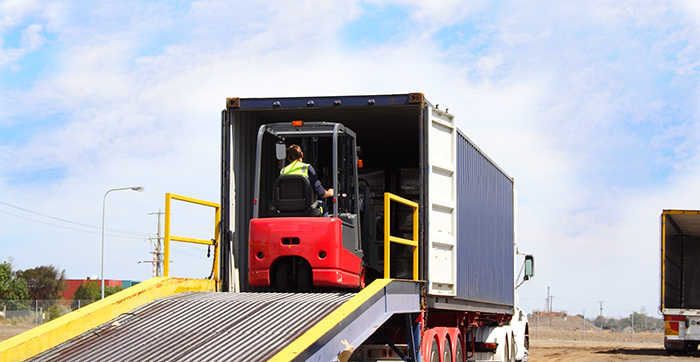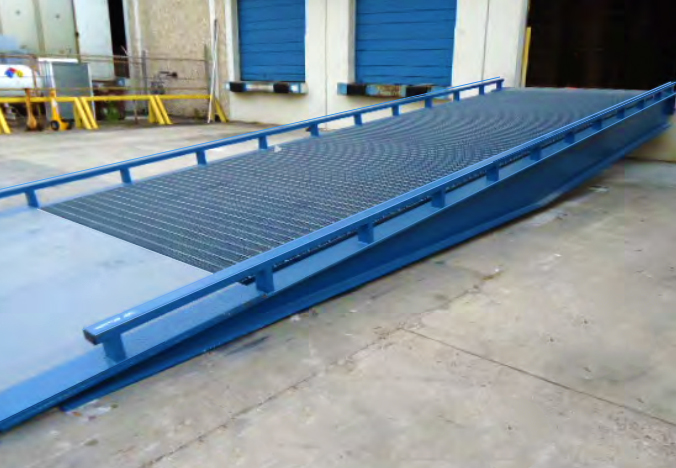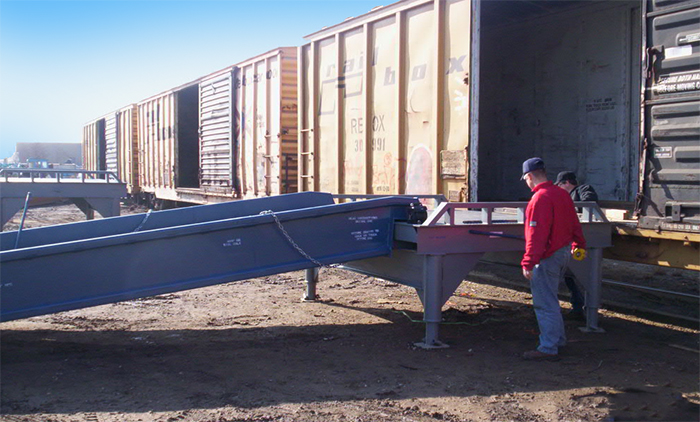When Should You Use a Yard Ramp?
A matter of frequency and flexibility

Yard ramps are great for letting you load trailers in situations where you can’t back them to a dock because they can easily adjust to trailer heights. You can also use them to connect dock height to the ground in situations where that’s necessary. Beyond these basic situations, there are detailed reasons for using a dock ramp. Let’s look at those reasons:
Space limitations: the driving factor for many warehouses
Not every warehouse has the luxury of a dedicated loading dock area, or the luxury of enough bays to clear every truck that needs to be loaded or unloaded. When shipments can’t be processed due to this congestion, yard ramps can be a good alternative. These scenarios are mostly a function of space–or a lack of it– for shipping and receiving needs. If your facility needs to receive trailer trucks and has no truck-level dock, yard ramps are an ideal solution because they let you move palletized or other large loads in and out of the warehouse.

If you do have dock bays, but not enough of them to service your needs, yard ramps can be moved in and out of place when your docks are occupied. The queue of trucks waiting on space either to load or unload is reduced. Because ramps can be mobile, you only need a forklift to position them on any flat concrete to access a truck. This can be very useful for smaller LTL loads, where you need to plug a few pallets into a trailer, or take a few out. You can use your truck-high docks for higher volumes.
How often will you use the yard ramp?

Like any piece of equipment, one common sense way to look at it, is “how often will I need it?”
The constraints: what does dock congestion cost?
For yard ramps, that can be a simple analysis of flexibility: when you do need it, how important is it to have the flexibility a yard ramp provides? Are there too many trucks at your constrained docks too frequently, and what does that cost? What’s the production impact of late deliveries or late shipments?
When you have that permanent dock, and can’t service your needs consistently yard ramps become more justifiable when they delay the need for expansion or even facility relocation.
Do you need more loading and unloading flexibility?

Sometimes, it’s a matter of operational flexibility: can you load all the types of vehicles and shipments when and where you need to?
Can you adjust to situations as they occur? We all know that shipping and receiving can be inherently chaotic — that a warehouse or traffic manager can’t control what’s coming in or going out on a particular day. If your best customer needs and emergency shipment and it has to go today, extra loading slots may be invaluable.
- Portable ramps let you position trailers and loads anywhere you have adequate ground.
- Yard ramps with casters can be moved anywhere you need to access a truck trailer or other vehicle.
- You can lower or raise the ramp’s height, so it’s flexible in terms of the kinds of trailers it can access.
- The ability to serve different types of vehicles or platforms or docks can be extremely valuable.
The cost of dock inefficiency can be high, so the flexible nature of ramps becomes more valuable.
How to specify a yard ramp
- Weight capacity: To specify a yard ramp, you need to add the weight of your forklift to the weight of your heaviest projected load. Any yard ramp you use must be capable of handling the total. Standard ramps range from 60,000 to 100,000 pounds capacity. Capacity should be considered a working capacity, not simple weight bearing.
- Your forklift widths: Standard forklifts range from 4 feet to a high end of about 7 feet wide. Your ramp must be wide enough to accommodate your widest forklift.
- Length of your ramp: Most loading to trailers is done with about 30′ of ramp then a level off area.
- Dock-to ground stationary ramps: If you’re bridging from the ground to a dock for the typical 39″ to 60″ range, you can use a 30′ incline ramp. Be sure you won’t need to frequently move the ramp. This makes good sense for facilities that receive bulk shipments in the yard or accommodate a broad range of vehicles that can’t use standard docks.
- Ground-to-truck portable ramps: These ramps feature level off zones at the top to bridge to a truck trailer. That flat zone length varies by truck and load lengths, with 6 feet being a common specification. As with dock level ramps, you’ll need maneuvering space
- Ramp height: Will your ramp need to be adjustable for the vehicles or platforms it loads? Be sure that the ramp you specify can cover all situations.
Questions? Contact us for specification assistance, as there are many factors to consider for safe, efficient operation.
Read more
- OSHA: Loading and Unloading
- Yard Ramps: 4 Critical Specification Factors
- How to Help Drivers Park Faster & Safer at Your Truck Docks
Tags: forklifts, Receiving, shipping
Evan Fleishacker



